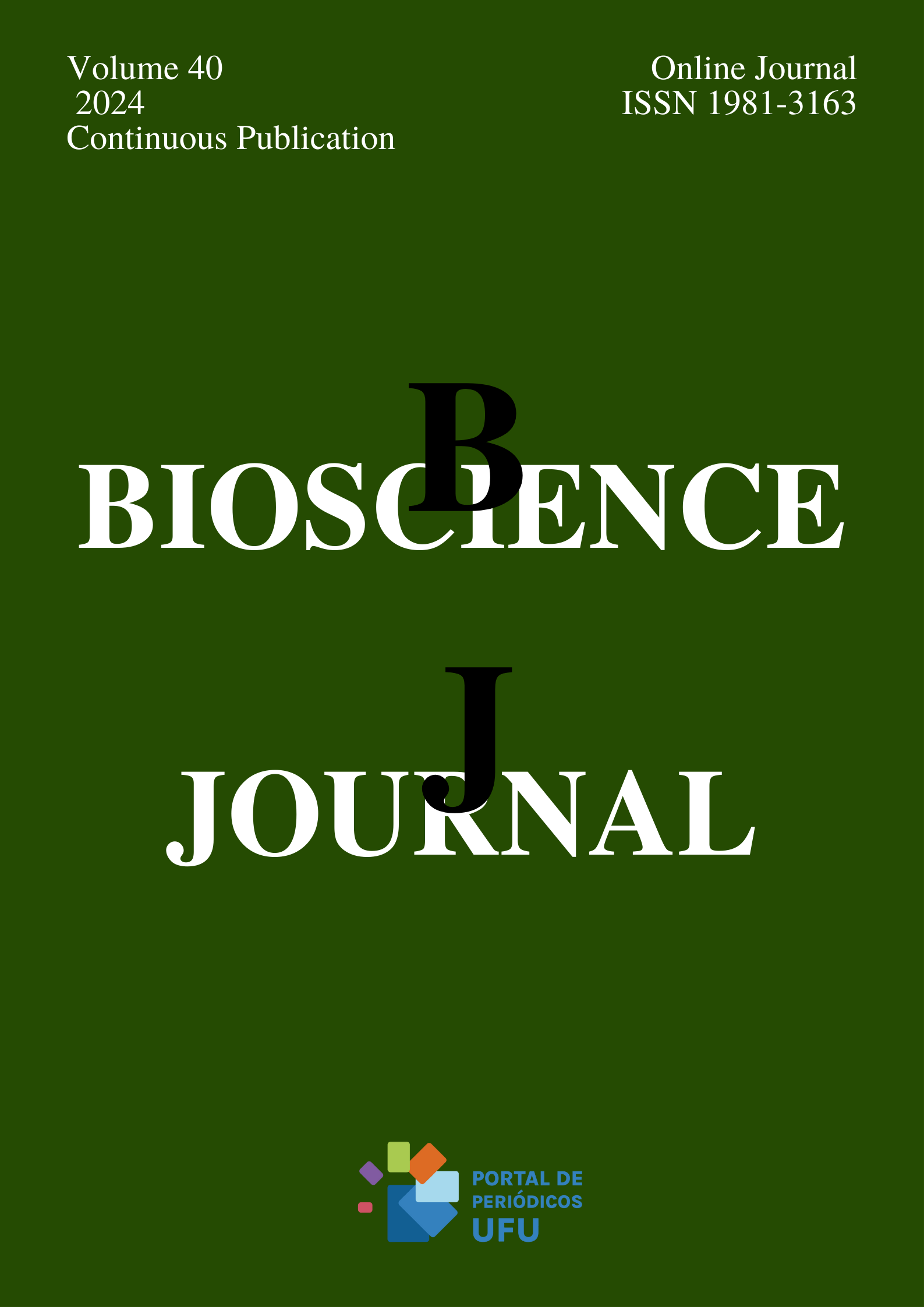Natural dentifrices: how can prolonged toothbrushing influence enamel color and surface roughness?
DOI:
https://doi.org/10.14393/BJ-v40n0a2024-68831Keywords:
Dentifrices, Natural products, Oral health, Toothbrushing, Toothpaste, Whitening.Abstract
This study evaluated the color change (ΔE00) and surface roughness (Ra) of enamel submitted to prolonged toothbrushing with natural non-fluoride dentifrices. Five groups of bovine teeth (n=10) were brushed with a control dentifrice: (C) Colgate Total 12 – Colgate; and four natural dentifrices: (R) Restore – Jeunesse; (OG) OnGuard – doTerra; (OC) OzonCare – Philozon; and (N) Natural activated charcoal – Suavetex. Mechanical toothbrushing simulated one month (T1), six months (T2), one year (T3), and two years (T4) of product use. ΔE00 and Ra were measured before and after toothbrushing. Two-way repeated measures ANOVA and Tukey's test were performed. Dentifrice (p<0.001), toothbrushing time (p=0.004), and their interaction (p=0.031) influenced color change (ΔE00). Natural dentifrices promoted similar color change and Ra to the traditional product. After six months of simulated toothbrushing, OG promoted more color changes than N and R. Only OG and R reached ΔE00 above the acceptability threshold. OC and N dentifrices generated Ra above the limit of clinical roughness from T2. Toothbrushing with natural toothpaste for up to two years causes similar enamel color changes and roughness to the traditional product.
References
BOLLEN, C.M.L., LAMBRECHTS, P. and QUIRYNEN, M. Comparison of surface roughness of oral hard materials to the threshold surface roughness for bacterial plaque retention: A review of the literature. Dental Materials. 1997, 13, 258–269.
BROOKS, J.K., BASHIRELAHI, N. and REYNOLDS, M.A. More on charcoal and charcoal-based dentifrices. Journal of the American Dental Association. 2017, 148(11), 785. https://doi.org/10.1016/j.adaj.2017.09.027
CARVALHO, R.F., et al. Does polishing of bleached enamel affect roughness and tooth color stability after exposure to coffee? Journal of Esthetic and Restorative Dentistry. 2022, 34(2), 351-359. https://doi.org/10.1111/jerd.12869
CURY, J.A. and TENUTA, L.M.A. Evidence-based recommendation on toothpaste use. Brazilian Oral Research. 2014, 28, 1-7. https://doi.org/10.1590/S1806-83242014.50000001
DEVILA, A., et al. Efficacy and Adverse Effects of Whitening Dentifrices Compared With Other Products: A Systematic Review and Meta-analysis. Operative Dentistry. 2020, 45(2), E77-E90. https://doi.org/10.2341/18-298-L
DIETRICH, L., et al. A meta-analysis of ozone effect on tooth bleaching. Scientific Reports. 2021, 11(1), 13177. https://doi.org/10.1038/S41598-021-92733-8
EISENBERG, D.M., et al. Trends in alternative medicine use in the United States, 1990-1997: results of a follow-up national survey. Journal of the American Medical Association. 1998, 280(18), 1569-1575. https://doi.org/10.1001/jama.280.18.1569
EMÍDIO, A.G., et al. In vitro assessment of activated charcoal-based dental products. Journal of Esthetic and Restorative Dentistry. 2023, 35(2), 423-430. https://doi.org/10.1111/jerd.12982
GANSS, C., et al. Conventional and anti-erosion fluoride toothpastes: effect on enamel erosion and erosion-abrasion. Caries Research. 2011, 45(6), 581-589. https://doi.org/10.1159/000334318
GILES, A., et al. Clinical in situ study investigating abrasive effects of two commercially available toothpastes. Journal of Oral Rehabilitation. 2009, 36(7), 498-507. https://doi.org/10.1111/j.1365-2842.2009.01965.x
GOLDSTEIN, B.H., & EPSTEIN, J.B. Unconventional dentistry: Part IV. Unconventional dental practices and products. Journal of Canadian Dental Association. 2000, 66(10), 564-568.
JACOBSEN, P.L., EPSTEIN, J.B. and COHAN, R.P. Understanding “alternative” dental products. General Dentistry. 2001, 49(6), 616-620.
KAMIYA COPPINI, E., et al. Surface roughness evaluation and whitening efficiency on tooth enamel after using whitening toothpaste: a randomized double-blinded study. Bioscience Journal. 2022, 38, e38056. https://doi.org/10.14393/BJ-v38n0a2022-59876
KRITHIKADATTA, J., GOPIKRISHNA, V. and DATTA, M. CRIS Guidelines (Checklist for Reporting In-vitro Studies): A concept note on the need for standardized guidelines for improving quality and transparency in reporting in-vitro studies in experimental dental research. Journal of Conservative Dentistry. 2014, 17(4), 301.
LAW, V., et al. Effect of whitening dentifrices on toothbrush abrasion on composites. American Journal of Dentistry. 2022, 35(2), 161-164.
LUO, M.R., CUI, G. and RIGG, B. The development of the CIE 2000 colour-difference formula: CIEDE2000. Color Research & Application. 2001, 26(5), 340-350. https://doi.org/10.1002/col.1049
MATHIAS-SANTAMARIA, I.F., et al. Activated Charcoal Dental Products: Evidence of Effectiveness Is Lacking. Compendium of Continuing Education in Dentistry. 2022, 43(9), 612-615.
MAZUR, M., et al. Green dentistry: Organic toothpaste formulations. A literature review. Dental and Medical Problems. 2022, 59(3), 461-474. https://doi.org/10.17219/dmp/146133
MIOTTI, L.L., et al. The Use of Resin Composite Layering Technique to Mask Discolored Background: A CIELAB/CIEDE2000 Analysis. Operative Dentistry. 2017, 42(2), 165-174. https://doi.org/10.2341/15-368-L
PARAVINA, R.D., et al. Color difference thresholds in dentistry. Journal of Esthetic and Restorative Dentistry. 2015, 27(Suppl 1), S1-S9. https://doi.org/10.1111/jerd.12149
PIEKARZ, T., et al. The Influence of Toothpaste Containing Australian Melaleuca alternifolia Oil and Ethanolic Extract of Polish Propolis on Oral Hygiene and Microbiome in Patients Requiring Conservative Procedures. Molecules. 2017, 22(11), 1957. https://doi.org/10.3390/molecules22111957
RASHRASH, M., SCHOMMER, J.C. and BROWN, L.M. Prevalence and Predictors of Herbal Medicine Use Among Adults in the United States. Journal of Patient Experience. 2017, 4(3), 108-113. https://doi.org/10.1177/2374373517706612
ROSELINO, L.M.R., et al. Effect of Brushing Time and Dentifrice Abrasiveness on Color Change and Surface Roughness of Resin Composites. Brazilian Dental Journal. 2015, 26(5), 507-513. https://doi.org/10.1590/0103-6440201300399
SANCHEZ, N., FAYNE, R. and BURROWAY, B. Charcoal: An ancient material with a new face. Clinics in Dermatology. 2020, 38(2), 262-264. https://doi.org/10.1016/j.clindermatol.2019.07.025
TOMÁS, D.B.M., PECCI-LLORET, M.P. and GUERRERO-GIRONÉS, J. Effectiveness and abrasiveness of activated charcoal as a whitening agent: A systematic review of in vitro studies. Annals of Anatomy. 2023, 245, 151998. https://doi.org/10.1016/j.aanat.2022.151998
VALONES, M.A.A., et al. Clinical Assessment of Rosemary-based Toothpaste (Rosmarinus officinalis Linn.): A Randomized Controlled Double-blind Study. Brazilian Dental Journal. 2019, 30(2), 146-151. https://doi.org/10.1590/0103-6440201902164
WELZ, A.N., EMBERGER-KLEIN, A. and MENRAD, K. Why people use herbal medicine: insights from a focus-group study in Germany. BMC Complementary and Alternative Medicine. December 15, 2018, 18(1), 92. https://doi.org/10.1186/s12906-018-2160-6
Downloads
Published
Issue
Section
License
Copyright (c) 2024 Murilo Guimarães Campolina, Lia Dietrich, Alexia da Mata Galvão, Hugo Lemes Carlo, Maria Antonieta Veloso Carvalho de Oliveira, Gisele Rodrigues da Silva

This work is licensed under a Creative Commons Attribution 4.0 International License.





